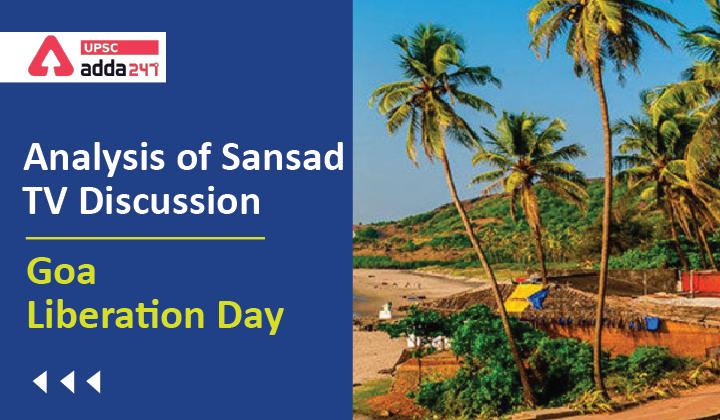Table of Contents
Context
ON December 19, 2021, Goa completes 60 years of its liberation from Portugal’s colonial rule and integration into the Indian union.
Introduction
- Even as India became independent on August 15, 1947, Goa continued to be under Portuguese rule 14 years after that.
- After India’s independence from the British in 1947, the calls for Goa’s Liberation again gathered steam.
- After multiple agitations by freedom fighters, India made peaceful attempts for Goa’s liberation through diplomatic channels.
- However, as a last resort, the Indian government then led by Prime Minister Jawaharlal Nehru, sent in its armed forces to the coastal state after which the Portuguese surrendered and Goa was liberated on December 19, 1961.
- This moment also marked the exit of the Portuguese, the last of the European colonisers to leave India.
Why does Goa observe liberation day on December 19?
- An important port for trade and military operations, Goa was ruled by the Portuguese for more than 450 years.
- While historically, revolts against Portuguese rulers and their policies were recorded in the 18th and 19th century too, on June 18, 1946, the movement of Goa’s liberation gathered momentum after socialist leader Dr Ram Manohar Lohia plunged himself into the freedom movement with many young Goans.
- The day is now observed as Goa Revolution Day. However, even as India became independent on August 15, 1947, Goa continued to be under Portuguese rule 14 years after that.
- After India’s independence from the British in 1947, the calls for Goa’s Liberation again gathered steam. After multiple agitations by freedom fighters, India made peaceful attempts for Goa’s liberation through diplomatic channels.
- However, as a last resort, the Indian government then led by Prime Minister Jawaharlal Nehru, sent in its armed forces to the coastal state after which the Portuguese surrendered and Goa was liberated on December 19, 1961.
- This moment also marked the exit of the Portuguese, the last of the European colonisers to leave India.
What was ‘Operation Vijay’?
- Perhaps the first tri-service operation of the Indian armed forces, Operation Vijay was about the liberation of the Portuguese territories of Goa, Daman and Diu.
- While the Indian government was prepared to take military action since the beginning of December 1, it culminated into the 36-hour military operation that started on December 18, 1961, and concluded on December 19, 1961.
- While the army advanced into Goa from the North and the East, the Indian Air Force bombed the Portuguese airbase at Dabolim.
- The Indian Navy was tasked with preventing hostile action by Portuguese warships, securing access to the Mormugao harbour, and securing the Anjadip island off Karwar.
- By the evening of December 19, 1961, Portuguese Governor General Vassalo De Silva had signed the document of surrender after Indian armed forces, led by the army and backed by the air force and navy, had outnumbered and overwhelmed the Portuguese. Goa was then brought under the control of the Indian government.
- This special episode of history is etched on the war memorial at Indian Naval Ship Gomantak, constructed in memory of seven young sailors and other personnel who laid down their lives in “Operation Vijay” that led to Goa’s liberation.
- The Prime Minister released a Special Cover and Special Cancellation to mark the commemoration of the Indian Armed Forces freeing Goa from Portuguese rule.
What kind of International Pressure did India face after Operation Vijay?
- The Western media assailed the action in ”Operation Vijay” as a display of “Indian hypocrisy”, which represented a breach of international law by a nation that professed non-violence.
- Though the liberation of Goa by force raised the prestige of the government in India, it adversely affected Nehru’s international image, but only briefly.
- American President Kennedy told B.K. Nehru, India’s ambassador to the U.S., that after taking military action in Goa, Nehru may not be able to talk of non-violence as he did before. But Kennedy came to India’s rescue in India’s 1962 conflict with China.
What happened after the liberation of Goa?
- Goa was annexed into the Indian union and was the Union Territory of Goa, Daman and Diu.
- The Union Territory status that Nehru accorded Goa lasted 27 years. Goa attained statehood in 1987.
- In 1967, however, the question of whether the state should merge with Maharashtra or not was answered through a plebiscite in which the majority of the Goan people voted against a merger.
- It continued to remain a Union Territory until 1987 when it was accorded statehood.
- Goa became India’s 25th state even as Daman and Diu continue to be Union Territories.



 TSPSC Group 1 Question Paper 2024, Downl...
TSPSC Group 1 Question Paper 2024, Downl...
 TSPSC Group 1 Answer key 2024 Out, Downl...
TSPSC Group 1 Answer key 2024 Out, Downl...
 UPSC Prelims 2024 Question Paper, Downlo...
UPSC Prelims 2024 Question Paper, Downlo...




